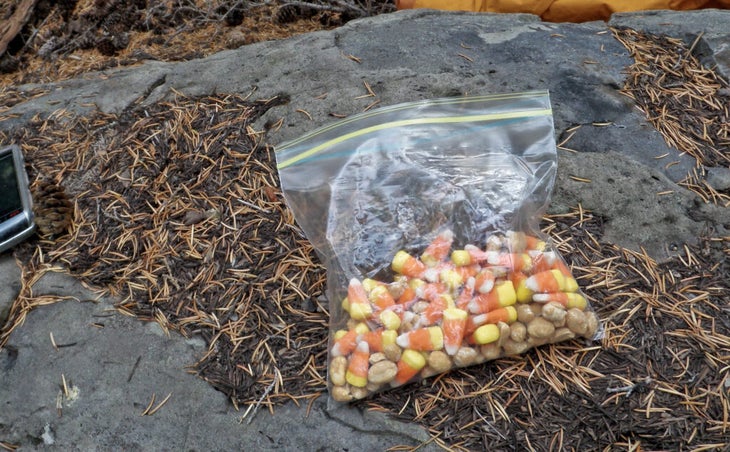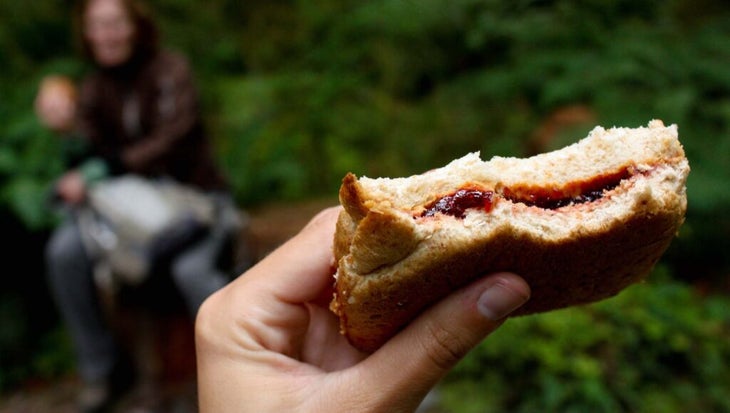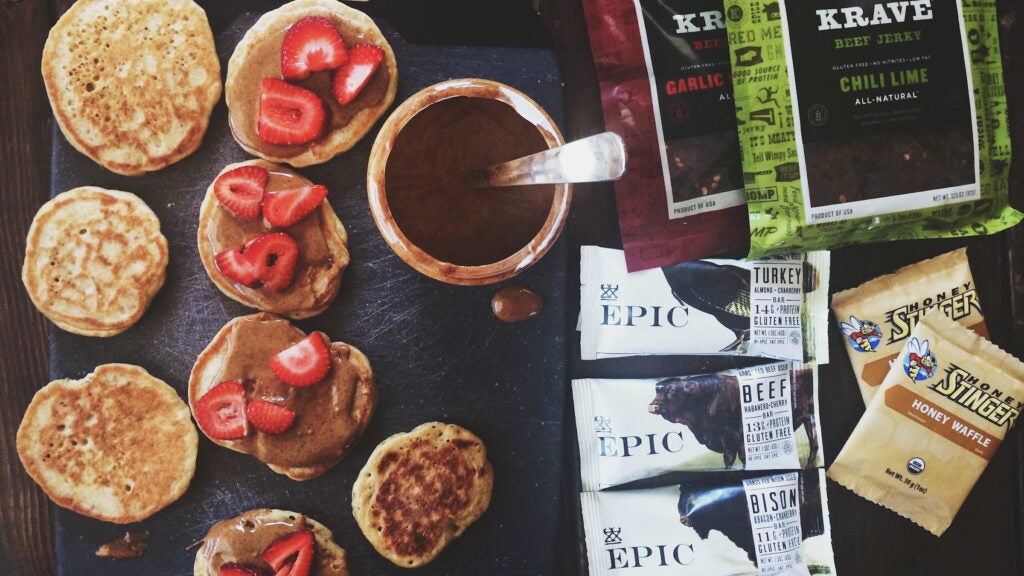“], “filter”: { “nextExceptions”: “img, blockquote, div”, “nextContainsExceptions”: “img, blockquote, a.btn, a.o-button”} }”>
Heading out the door? Read this article on the new Outside+ app available now on iOS devices for members!
>”,”name”:”in-content-cta”,”type”:”link”}}”>Download the app.
We live in a world where hiking nutrition advice abounds—and often contradicts. I’ve seen peanut butter chided as a “naughty spread” in some articles and hailed as a protein-packed powerhouse in others. Some years, high-fat diets are regarded with horror while in others, they’re touted as the answer to weight loss, ketosis, and eternal youth.
While hiking nutrition counsel tends to be more practical, it doesn’t exist in a vacuum. Much of the advice we receive is filtered down to the hiking realm through layers of diet culture and sensationalist media. And the truth is that we still don’t know very much about how the body works. Digestion—and the way certain foods and nutrients affect the body—is incredibly complex and ridiculously varied. It’s rarely the same from person to person. Which is why diet fads like probiotic supplements, intermittent fasting, and even increased protein intake are poorly understood.
To get to the bottom of a few of the more common myths, I spoke to Katie Barylski, the registered dietician and lifelong hiker behind Revival Nutrition Counseling in Boulder, Colorado. Here’s her take on eight common misconceptions.
Myth: Simple sugars are bad for you. Complex carbs are always a better choice.
Fact: When people talk about “sugar” or “simple sugars” being bad for you, they’re primarily talking about processed sugars. This is the kind of sugar you find in candy and cookies—not the kind you find in sweet potatoes or dried fruit, Barylski says.
“I don’t want to say that there are zero negative health impacts associated with eating too much [processed] sugar,” she explains. “That said, simple sugars do have a place. They can certainly be part of a satisfying, nourishing, and sustainable dietary pattern. And they really shine on longer or more challenging hikes.”
Simple sugars are a readily available source of glucose, which is the primary fuel for our brains as well as our bodies. On hikes, they can lift mood and keep energy levels up. And when we’re moving quickly, they’re actually a better choice than complex carbs like starches or whole grains because we receive energy from simple sugars faster. “In some cases, complex carbs can lead to digestive distress and impact performance negatively,” Barylski says.
Myth: Sugar causes inflammation.
Fact: Chronic inflammation—a type of full-body inflammation that can be associated with chronic disease—is a fairly new and poorly understood concept. And while people like to point to sugar as an easy scapegoat, there’s not really sufficient research supporting this, Barylski says.
“I think we generally over-emphasize the role of diet when there are so many other influences that can cause chronic inflammation,” she explains. “Stress, discrimination, access to safe and clean water, your environment, your home life—those factors often have much larger impacts on your health and your likelihood to have chronic inflammation or chronic disease than we give them credit for.” In fact, studies show that diet and exercise only make up a third of the factors that contribute to our health. The rest has to do with our genetics or environment—factors largely outside our control.
Although there is some research that shows that a diet heavy in simple sugars can be correlated to higher inflammation, that doesn’t necessarily make sugar the enemy, Barylski says
“Eating simple sugars, even regularly, as part of a diet that’s otherwise diverse in nutrients is not likely to be a cause for concern, especially if you’re protected from some of those other non-diet related variables,” she says. In other words, if you don’t suffer from systemic discrimination, poor drinking water, or chronic stress, your sugar intake is probably just a drop in the bucket.

Myth: If you bonk, it’s because you didn’t eat enough on the trail.
Fact: Hikers often think of bonking as a result of underfueling on the trail. But the reality is that bonking can have a number of different explanations, Barylski says. It could indicate that you ate too little breakfast that morning, or even too little the day before your hike.
You can also bonk just because you’re eating too little in your life in general. This is common among dieters, thru-hikers, and people who tend to have an imbalanced diet. If you’re operating on a calorie deficit in your everyday life, eating a big breakfast isn’t going to be enough to restore your energy to hiking-ready levels.
“Eating patterns over time matter,” Barylski says. “It’s not just about what you ate that day. If you’re not eating enough or there’s a complete imbalance in your diet, that can cause your hike to be compromised, too.”
Myth: Eating a high-fat snack before you get in your sleeping bag will help keep you warm at night.
Fact: Barylski says she hasn’t seen any scientific research on this (likely because there isn’t any), but she doubts the veracity. Temperature regulation has more to do with eating adequate and balanced amounts of macronutrients (proteins, fats, and carbs) throughout the day and your life in general, she explains. It’s not likely that a single snack right before bed will do much to affect your body temperature, even in the short term. (You’re better off sleeping with a hot water bottle or doing some crunches before bed.)
“If you’re generally operating on a calorie deficit, you’re far more likely to struggle with temperature regulation than if you are otherwise well nourished,” Barylski says.
Myth: You should avoid eating protein mid-hike because it’s tough to digest.
Fact: Hiking publications (including Backpacker) often recommend that hikers prioritize fats and carbs on the trail. Typically, the advice goes, you should only load up on protein once you’re in camp, since it’s most effective in helping your muscles recover. But Barylski says that’s not necessarily the best advice.
“It’s true that focusing more on carbohydrates may be more appropriate for high-intensity hikes, since carbohydrates take less energy to digest,” she says. “But if you’re on a dayhike or moving at a more moderate pace, the best recommendation is to pair carbohydrates with protein for sustained energy.”
Protein, she says, can be slightly easier to digest than high-fat or high-fiber foods. Pairing proteins with carbs (think: pretzels and jerky or a PB&J sandwich) can help slow down digestion and give you a more consistent release of energy, rather than a blood-sugar spike and crash.
“Fats can also be paired with carbs and have a similar slowing effect on that insulin response,” Barylski says. “But fats are one of the harder things for our bodies to break down. So, on the trail, eating something high in fat might be more likely to lead to digestive distress.”

Myth: Dehydrated and freeze-dried foods have less nutritional value than fresh foods.
Fact: Contrary to popular belief, the dehydration process doesn’t actually sap foods of their nutritional value.
“[Backpacking meals] retain the vast majority of nutrients, minerals, and vitamins,” says Barylski. “But if someone is worried about vitamin or mineral degradation, they can supplement with a daily multivitamin.” She recommends taking that vitamin with food for better digestion and making sure it’s a high-quality vitamin. Supplements aren’t regulated by the U.S. Food and Drug Administration (FDA), so look for “USP” on the label—the highest level of regulation that is available.
Myth: Skipping breakfast before your hike is an effective way to burn more fat.
Fact: We’re looking at you, intermittent fasters. “While skipping breakfast may impact the type of energy your body uses on your hike, it’s not the most metabolically efficient option. And it’s not without a cost,” Barylski says. “The most likely risks include hitting a wall more quickly, irritability, and nausea or digestive distress.”
Some people can indeed skip breakfast without any ill effect. But most folks experience low energy, irritability, and brain fog (i.e. hanger) as a result of low blood sugar. When your blood sugar drops, cortisol and other stress hormones spike, which is why you get cranky.
The other problem, Barylski adds, is that it’s not just fat that gets broken down when you’re low on fuel.
“Your body also needs amino acids, and it gets those via the breakdown of muscle,” she says. Weight-loss dogma usually teaches that fat breakdown happens first, and muscle breakdown only happens if you run out of fat. But Barylski says these processes often begin simultaneously. Our bodies aren’t as picky as we would like them to be, and there’s not really a way to control or target fat burn.
Myth: Getting thinner will make you better at hiking.
Fact: In social media comments (for this publication and others), I often see folks suggest that being overweight makes you worse at hiking. Others seem to believe that thinness is a good metric of health and fitness. Barylski says these ideas are just stereotypes—and that they’re objectively untrue. Copious scientific research indicates that weight is not actually a determinant of health.
“Culturally we’re taught that it’s OK and even reasonable to make judgments about people’s health based on what they look like,” Barylski says. “This is unhelpful at best and actively harmful at worst. There’s so much that goes into weight. There are thin people who are not fit or healthy, and fat people who are fit and healthy.” So, just because you’re a thin hiker doesn’t mean you’re in the clear or that you can neglect your diet on the trail. Likewise, if you’re a bigger hiker, you don’t necessarily need to adjust your eating habits or lose weight to improve your hiking performance. And, no matter your body size, you don’t have the right to comment on others.
